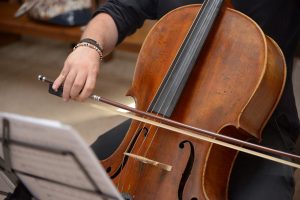Greetings! I know I haven’t written in a while. I’ve been busy with teaching, orchestras, accompanying, and oh yes, there’s life outside of music too!
In fact, I have had so much music to learn and play lately, that it’s become overwhelming at times. Sometimes I have so much to do that I don’t know where to start and end up wasting time and not getting much done.
When I discussed this with my teacher, she suggested the 5 minute rule. Set a timer and focus on the parts that need the work for only 5 minutes, then go to the next piece. Well, 5 minutes FLIES by, so I decided that I’d have the 10 minute rule. This is really a great idea. It forces you to focus. You can’t waste your time playing just the “easy parts” and you really work the hard parts.
As an example, I have this part in the Mendelssohn Violin Concerto in E minor: 
It’s the 1/8 notes, of course, and while they aren’t difficult to play, take into consideration that it’s in 2 rather than 4, and 1/2 note=100. SO it’s quite quick! I use a variety of methods to increase my speed. (1) play 4 notes fast, count to 4, then play the next 4;
(2) play with different rhythms;
(3) Play 2 notes fast, then add 2 notes. Play the next 2 and add 2. Play all together and keep growing.
Believe me, 10 minutes of this intense work is plenty. If I can get this to 100, I’m happy! (I’m at 80 now, so we have a long way to go!)
Then I’m on to my next challenge- and since I only have 10 minutes, I have to get down to work fast. I use Alexa to set the timer and I plan what I need to work on before I start. I still take breaks after 30 minutes, but I find this to be more productive and I actually can measure some progress.
Would love to hear how you deal with time constraints! We all have them. Thanks!




 Again, the same weirdness. The first two measures slowly teach the shifts and spacing to move from one position to the next, but in the third measure you again have the strange notes of G flat-F sharp-E, and in the next line B flat-A sharp-A flat. It makes no sense. But a misprint over and over? I wasn’t sure if it was an error, or if Matz was trying to teach me some new technique, as odd as it seemed. So I presented this to some experts (internet cello experts) who agreed that it was a GROSS misprint, and called it “ECF”- Error Carried Forward. My teacher had seemed pretty sure it was a misprint, but it was hard for me to believe that a misprint/mistake could continue repeatedly in the music.
Again, the same weirdness. The first two measures slowly teach the shifts and spacing to move from one position to the next, but in the third measure you again have the strange notes of G flat-F sharp-E, and in the next line B flat-A sharp-A flat. It makes no sense. But a misprint over and over? I wasn’t sure if it was an error, or if Matz was trying to teach me some new technique, as odd as it seemed. So I presented this to some experts (internet cello experts) who agreed that it was a GROSS misprint, and called it “ECF”- Error Carried Forward. My teacher had seemed pretty sure it was a misprint, but it was hard for me to believe that a misprint/mistake could continue repeatedly in the music.